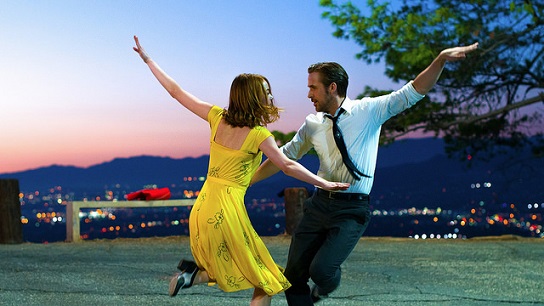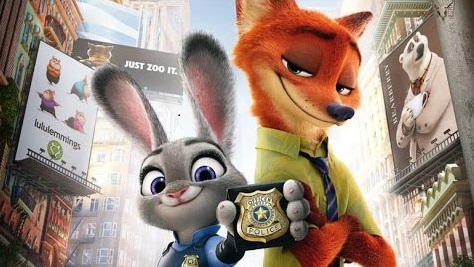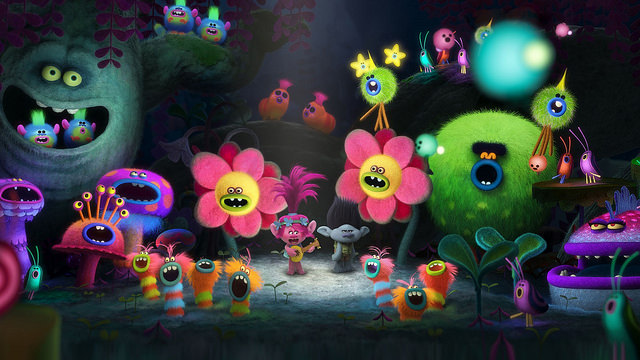
Even before films had dialogue, they had music. In the silent film era, the music was necessary to emphasize emotions conveyed on screen. Today, different filmmakers use music in different ways. In musicals like La La Land or Moana, songs are necessary to advance the plot and communicate the the emotions of the characters. Take out a song from a musical and a piece of the story is missing. In documentaries, such as The 13th and Jim: The James Foley Story, original songs play an important role in setting tone and summarizing the thesis of the film. In non-musical, fiction films like Hidden Figures, in addition to setting tone, original songs are a way for filmmakers to advertise their films in audial mediums, the song being a distillation of the major ideas of the film.
Herein, we give you some of the tracks nominated for Academy Awards for Best Original Song, in addition to original songs in films nominated in other categories, like Best Picture, Best Animated Feature, and Best Documentary Feature. These films were some of the best of 2016; let’s explore the use of their original songs!
City of Stars and Audition (Fools Who Dream)
by Justin Hurwitz, Benj Pasek, and Justin Paul from La La Land

La La Land, a musical rollercoaster of euphoria and heartbreak, tells the story of two creative people living in L.A. struggling to realize their dreams. Mia (played by Emma Stone) tries to make it as an actress and piano man Sebastian (Ryan Gosling) attempts to open a jazz club, all while both trying to maintain a romantic relationship.
The two sing “City of Stars” early on in their courtship. A love song for each other and to their dreams, “City of Stars” propels the film into the second act. On the one hand, through its lighthearted tempo and hopeful lyrics, the song captures the excitement of embarking on a journey. On the other hand, the constant ascending and descending quarter-notes in the bassline—like waves on a sandy beach moving in one direction and then withdrawing—match the characters’ trepidation. As an audience, we are thinking: will they achieve their dreams?
Near the end of the film, Mia sings “Audition (Fools Who Dream).” At this point, she and Sebastian have attained some of their aspirations, but not others. “Audition (Fools Who Dream)” captures the fear and joy of having unrealized hopes, much like “City of Stars.” However, “Audition (Fools Who Dream)” communicates much more happiness, in particular in the middle section in which the sound of a major key, quickened tempo, and the encouraging lyrics bring forth positive and joyful feelings. The song reminds the audience that it’s worth pursuing your dreams even if life’s realities fall short.
How Far I’ll Go and We Know The Way
by Lin-Manuel Miranda and Opetaia Foa'i from Moana

The latest Disney animated musical features its first ever South Asian “princess” Moana, daughter of Polynesian chief. In the same vein as many Disney animated musical, “How Far I’ll Go” expresses Moana’s desire to see more of the world beyond her island and reef. Placed early on in the film, it’s reminiscent of Ariel’s cry to “be where the people are” in “Part Of Your World” in The Little Mermaid. It’s a call to action which charges not only Moana but also the audience to embark on a great adventure.
For Moana, the adventure is saving her island Motunui—the people, animals, and plants on it—from the dead crops and barren waters plaguing their ecosystem. In order to do so, Moana must travel across the sea to return the heart of a goddess. However, Moana, like her fellow islanders, has never left the reef. “We Know The Way” is sung to inspire Moana to have faith in her roots and cast off. Its lyrics include how ancient Polynesian tribes used the sun, stars, and winds to navigate thousands of miles of Pacific Ocean to find new islands and fisheries. Moana uses the knowledge of her ancestors to complete her journey and discover more about herself.
The Empty Chair
by Sting and J. Ralph from Jim: The James Foley Story
Jim: The James Foley Story is a documentary about the life and death of journalist James Foley, who was captured by ISIS in 2012 and beheaded in 2014. Directed by James Foley’s childhood friend, Brian Oakes, the film itself is chilling and devastating. Through interviews with friends and colleagues, Jim: The James Foley Story paints an intimate picture of Foley—his bravery, courage, and empathy—beyond the infamous footage of his death. In fact, the film shies away from any direct discussion of politics, opting instead to explain Foley’s character and how his love and interest in people led to his working in war zones.
“The Empty Chair” at the conclusion of the film comprises of only Sting’s vocals and a beautiful piano melody. Composer J. Ralph describes the song as giving audience members “a bridge back to their lives.” He and Sting hoped to transpose this horrific experience in Syria back to Americans’ everyday lives. Sting achieves this through his mournful, vivid lyrics: “So many thousand miles over land and sea, I hope to dare, that you hear my prayer, and somehow I'll be there.” Sting sings of a concrete holding cell with Foley dreaming of his family in the United States, even including a detail from Foley’s relatives: “Well I was always late for every meal you'll swear.” In closing with “The Empty Chair,” the filmmakers have us feel like the loss of James Foley is each audience member's’ personal loss.
If you want to learn how to play this song, please see this video made by our guitar instructor, Ze, at Liberty Park Music:
Letter To The Free
by Common featuring Bilal from The 13th
Similar to “The Empty Chair,” “Letter To The Free” plays at the end of The 13th, a documentary about the racial history of crime, incarceration, and the justice system in the United States. The film looks at and uses music throughout as a means of separating chapters to explain why the 13th amendment to the U.S. Constitution—the one outlawing slavery—never really outlawed slavery but simply changed the procedures by which people are enslaved. Tracks heard in these interstitial moments include “Work Song” by Nina Simone and “Don’t Believe The Hype” by Public Enemy.
However, the film’s director Ava DuVernay (Selma) enlisted Common to craft the original rap song “Letter To The Free,” a somber conclusion to a harrowing film. In his verses, Common sums up the message of the whole film. While the rest of the documentary features footage of black prison inmates, black protesters, or black victims of police brutality and murder, “Letter To The Free” plays during the credits over archival images of black people being people: celebrating birthdays, going to dances, playing at the beach, eating family meals. As “freedom” is sung over and over again, it’s a reminder that all people just want to be free to live their lives.
Try Everything
by Sia Furler, Tor Hermansen, and Mikkel Eriksen from Zootopia

In Zootopia, a country bunny—Judy Hopps—moves to the metropolitan city of Zootopia to pursue a career as police officer, despite the fact that there’s never been a rabbit on the force. Zootopia shares many lessons with the audience, like how stereotyping is harmful to individuals and society.
In the song “Try Everything,” Shakira—playing Gazelle, a pop star—affirms the message that everyone makes mistakes, but that we should keep trying to achieve our goals and be the best we can be. “I keep falling down, I keep on hitting the ground / I always get up now to see what’s next.” “Try Everything” is first heard in a montage as Judy travels away from her small town for the first time to enter Zootopia. It foreshadows Judy’s challenges with integrating into the police force. “Try Everything” is played again at the end of the film during the credits, a testament to how Judy’s perseverance allowed her to grow and make her city a better place.
Runnin
by Pharrell Williams from Hidden Figures
Pharrell Williams’ “Runnin” is an uptempo, jazzy song that plays a pretty large role in the film Hidden Figures about three female, black NASA “computers” in the 1960s who were integral in Project Mercury, the U.S.’s first human spaceflight program. At the start of the film, the three women are late to work because their car broke down. They’re literally running late until they get a convoy from a state trooper—an incredibly rare thing given the racial prejudices at the time—after flashing their NASA credentials.
Later, one of the women, Katherine Johnson (played by Taraji P. Henson) is sent to the Space Task Group, which has never had a black woman computer. Each day, Katherine has to run back to the West side of NASA’s campus just to pee. “Runnin” plays in the background over footage of Katherine running in heels in the hot sun or pouring rain. The quick tempo and syncopated rhythm highlight the anxiety over Katherine’s struggle. Pharrel sings “I don't want no free ride, I'm just sick and tired of runnin’,” illuminating the often invisible challenges placed on people of color because of racial prejudice. Katherine was just as good at her job as any of her white coworkers, but because of segregated bathrooms, she had to “run” nearly a mile to use the bathroom, while her coworkers could walk just down the hall.
Can’t Stop The Feeling!
by Justin Timberlake, Max Martin, and Karl Johan Schuster from Trolls

Of all the film tracks featured in this article, “Can’t Stop The Feeling!” is definitely the most catchy. The classic pop disco feel, complete with slick basslines and an explosive horn section, is sure to make you tap your feet. In Trolls, Poppy (played by Anna Kendrick) and Branch (played by Justin Timberlake) are trolls being sought after by Bergen, large creatures who are perpetually unhappy but discover that, by eating trolls, they can feel happiness for a moment.
The song is performed by Poppy and Branch at the end of the film to show the Bergen that they can be happy without having to eat trolls. “I got this feeling inside my bones,” Poppy sings at the very beginning of the song. In a later verse, Branch adds: “Ooh, it's something magical. It's in the air, it's in my blood, it's rushing on.” Branch was formerly a rarity—an unhappy troll—but he learned that happiness is something he can feel for himself through the things he loves, like singing, dancing, and Poppy. Thus, the song communicates the theme of the film: that happiness is an intrinsic feeling inside themselves that they can access through love and dance and enjoying good times with friends.
Interested in learning how to play this song? Take a look at this video made by one of our piano instructors here at Liberty Park Music:
Music is an integral part of films, and original songs can help filmmakers communicate meaning, tone, and characters’ convictions. The best films of 2016 also have some of the best songs—from the saccharine poppiness of “Can’t Stop The Feeling” to the somber notes of “The Empty Chair.” These original songs ranging vastly in composition, but regardless of style, they all help deliver the messages of their films. So the next time you’re at the movie theater and hear an original song, perhaps you’ll recognize how important it is to the film.
Ready to learn music?
Start learning with our 30-day free trial! Try our courses now!About Liberty Park Music
LPM is an online music school. We teach a variety of instruments and styles, including classical and jazz guitar, piano, drums, and music theory. We offer high-quality music lessons designed by accredited teachers from around the world. Our growing database of over 350 lessons come with many features—self-assessments, live chats, quizzes etc. Learn music with LPM, anytime, anywhere!
